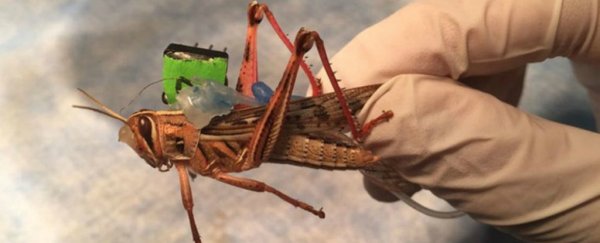A researcher in the US is developing technology that will enable locusts - those Biblical crop destroyers - to detect explosives hidden in hard-to-reach areas.
If successful, the technology has the potential to completely change the way bomb-diffusing teams seek out and dismantle hidden explosives - an operation that right now relies on both humans and dogs to get it done. Why not just send in a swarm of insects instead?
According to the brains behind the project, Baranidharan Raman from Washington University in St Louis, the locust project will combine the insect's ability to detect certain odours with a series of specialised electronics, making a kind of cyborg creature that's perfect for sniffing out bombs.
The system works by incorporating a heat-generating tattoo on the locust's wings that will throb with a very dull heat, allowing a team to control where the insect flies, and also allowing them to capture samples of organic compounds from the air around it.
Once at a potential bomb site, the locust's neural signals will be read by a small computer fixed to its body, and these signals will be decoded into a "yes" or "no" message. This message is sent back to the team, where it will either light up a red LED signal that a bomb is present, or a green LED signal that the area is clear.
But why use a living creature when you could just build a bomb-sniffing drone? Raman decided to take advantage of the natural olfactory systems inside a locust's nose, because it will not only save money in development costs - it could actually perform better than lab-made sensors.
"It took only a few hundred milliseconds for the locust's brain to begin tracking a novel odour introduced in its surroundings," Raman told the BBC. "The locusts are processing chemical cues in an extremely rapid fashion."
"Even the state-of-the-art miniaturised chemical sensing devices have a handful of sensors. On the other hand, if you look at the insect antennae, where their chemical sensors are located, there are several hundreds of thousands of sensors and of a variety of types," he added.
Right now, the brunt of bomb-sniffing is done by dogs, because they have one of the most powerful senses of smell in the animal world. But they do have downsides. It can take years to completely train a dog, and when one dies in the field, well, we don't even want to think about it, because it's too sad.
"The canine olfactory system still remains the state-of-the-art sensing system for many engineering applications, including homeland security and medical diagnosis," Raman said to Rob Crilly from The Telegraph.
"However, the difficulty and the time necessary to train and condition these animals, combined with [a] lack of robust decoding procedures to extract the relevant chemical sending information from the biological systems, pose a significant challenge for wider application."
Raman's half-robot locusts are still in the early testing phase, but he says the technology might be available within two years - a goal that seems all the more plausible after the US Office of Naval Research recently granted US$750,000 to fund the project.
Raman isn't the only researcher thinking outside the box about bomb diffusion. A group of researchers in Cambodia have been training rats to search for bombs, already leading to the safe disposal of over 4,599 land mines and 36,044 other unexploded ordnance in Cambodia alone.
According to a 2008 report by the United Nations, leftover land mines kill between 15,000 to 20,000 people ever year, wounding and disfiguring many more. With stats like that, it's no surprise that different solutions are continuously entering the fray.
Hopefully, as Raman's research continues, locusts will offer a safe way to detect hidden explosives, and make us all feel that much safer. But only time will tell how the insects operate in the field.
